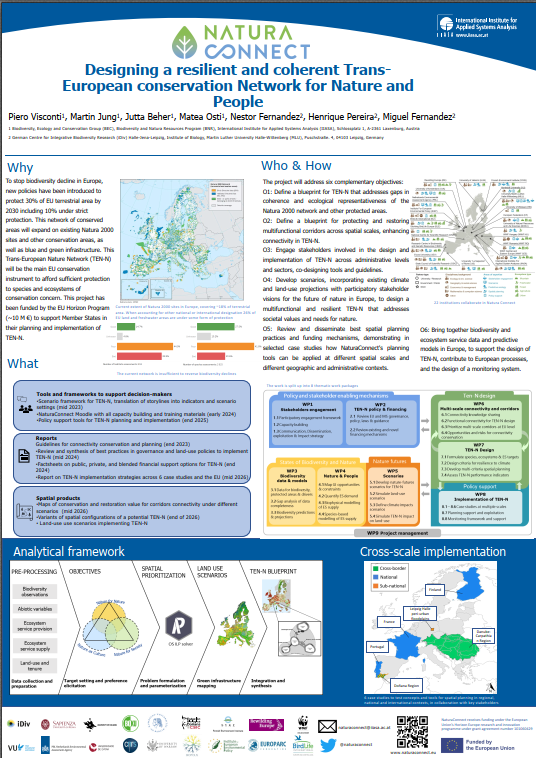NaturaConnect presented at the System Analysis for Reducing Footprints
and Enhancing Resilience conference
NaturaConnect was presented at the System Analysis for Reducing Footprints and Enhancing Resilience conference, jointly held by the International Institute for Applied Systems Analysis (IIASA) and the Austrian Academy of Sciences (OeAW).
The conference brought together over 550 participants, including researchers, policy makers and practitioners, with a focus on the use of systems analysis to address the complex problems of our time.
Systems analysis is a scientific research discipline which, at its simplest level, can be considered as a set of approaches for solving complex problems within systems – any set of interacting components, such as different species and anthropogenic uses in an ecosystem. IIASA has a long history (over 50 years) of interdisciplinary and international collaboration in applying systems analysis to find solutions to problems that impact multiple sectors of society.

The conference held several parallel sessions on:
- Understanding complex socio-environmental systems, in particular, advances in the increased computing capabilities and novel ways of analyzing data;
- Gathering and delivering information in creative ways (e.g. through citizen science, open science) and associated challenges; and
- Transdisciplinary research to facilitate science-informed decision-making, including policy co-design.
Jutta Beher, researcher with the NaturaConnect project and Research Scholar with the Biodiversity, Ecology, and Conservation Research Group at IIASA, presented a poster on NaturaConnect during the conference, highlighting how the project will apply a systems analysis approach, based on the best available scientific knowledge from different sectors such as conservation, land use and climate science. She shares some key takeaway messages from discussions during the poster presentation and the conference below.

- Systems analysis is useful for exploring solutions to complex problems
Systems analysis uses a structured approach to look at the many components that comprise a system, which helps in thinking about solutions to multi-faceted problems. Realistic insights into the likely consequences of decisions are the result of integrating objectives from all relevant sectors of society and the environment. The NaturaConnect project is an example of how this can be done, as research under the project will integrate information on anthropogenic land-use, species occurrence, and a range of possible future changes into a spatial prioritization process. This will produce multiple possible configurations of a network of protected areas across Europe, that achieve a set of objectives for both nature and people, and highlight trade-offs.
- Policy-relevant research should consider policy timelines and involve key stakeholders
Fitting policy-relevant research to policy timelines to ensure project outputs have a chance to inform policy is very important. To create impact through science, scientists need to talk to people in policy and other sectors. In NaturaConnect, we aim to establish a connection with key stakeholders early on in the process, to be able to develop our outputs in consultation with policy-makers and practitioners who need to make use of them.
- Biodiversity, ecosystems and habitats extend beyond administrative boundaries
Biodiversity, ecosystems and habitats are not confined to administrative boundaries, so modelling and planning for regions, countries or the entire EU need to consider areas beyond these boundaries to capture dynamics and dependencies of ecological systems and species – for example, when species need to move through landscapes. Connectivity and trans-boundary management are therefore some of the key aspects that NaturaConnect is considering as part of its analysis approach.
- Integrating different land management objectives in research can be challenging but is important
Stakeholders and sectors can have different objectives regarding land use and management, and challenges can arise when they lead to trade-offs. NaturaConnect is addressing this issue through engaging with key stakeholders throughout the process, to identify optimal protected area configurations that achieve the objectives of different sectors of society and conservation at the same time.
Conclusion
In summary, the conference served as an excellent opportunity to learn about other projects that are addressing similar challenges to NaturaConnect. NaturaConnect fits well into the world of integrated systems analysis, incorporating aspects that were highlighted as important for the success of any applied project that aims for implementation.







